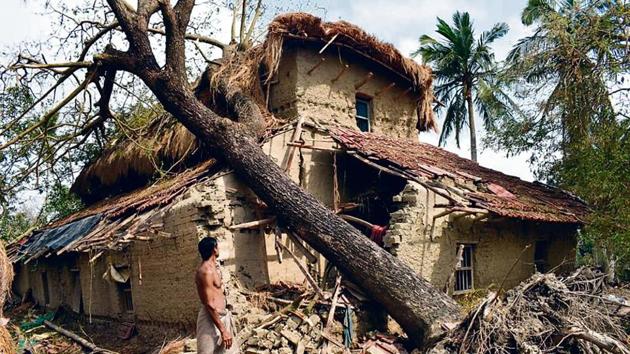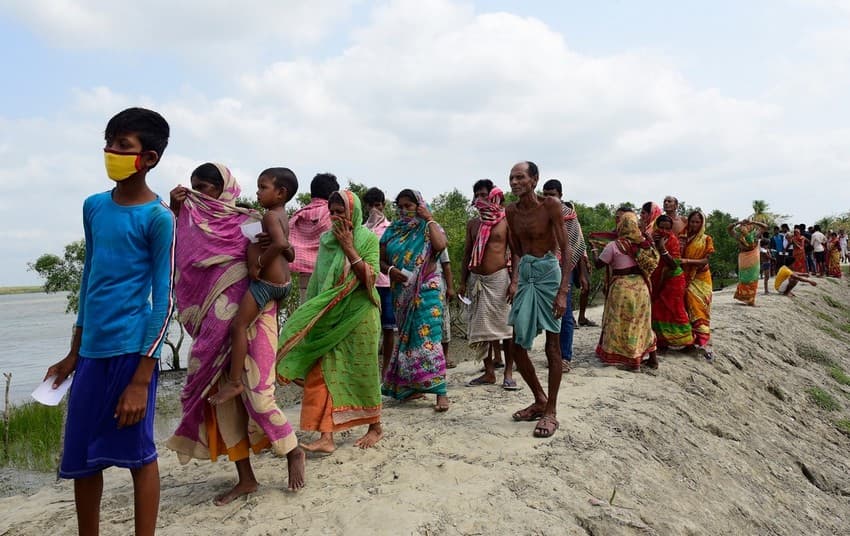Introduction
Ampan cyclone impact: The Sundarbans, a UNESCO World Heritage Site and the world’s largest mangrove forest stands as a testament to the power and beauty of nature. However, this delicate ecosystem is highly vulnerable to the ravages of natural disasters. In May 2020, Super Cyclone Amphan, one of the most powerful storms to hit the region in recent history, brought widespread devastation to the Sundarbans. This blog delves into the impact of Amphan on the Sundarbans, the challenges it poses, and the role of Rayal Sundarban Tourism in fostering resilience and sustainable recovery. This blog provides detailed information on “Ampan cyclone impact.”

The Fury of Super Cyclone Amphan
Super Cyclone Amphan made landfall on May 20, 2020, with winds reaching speeds of up to 165 kilometres per hour (103 mph). It was classified as a Category 5 storm, making it the first supercyclone to form in the Bay of Bengal since 1999. The cyclone’s powerful winds and heavy rains caused widespread destruction across the Sundarbans, impacting both the natural environment and the communities that depend on it. For further information, check out the section on “Ampan cyclone impact” in this blog.
Read More:
| Tracking Wildlife with Royal Sundarban Tourism Guides |
| Relaxing Retreats with Royal Sundarban Tourism |
| Medicinal Plants and Mangroves |
| Immersive Travel with Royal Sundarban Tourism |

Environmental Impact Of Sundarbans Cyclone Damage
- Mangrove Destruction: The Sundarbans’ mangrove forests, which act as a natural barrier against storms and tidal surges, suffered significant damage. The cyclone uprooted and snapped thousands of trees, reducing the forest cover and compromising the region’s ecological stability. The loss of mangroves not only affects biodiversity but also diminishes the forest’s ability to protect coastal areas from future storms.
- Wildlife Displacement: The Sundarbans are home to a rich array of wildlife, including the endangered Bengal tiger, saltwater crocodiles, and various bird species. The cyclone’s impact disrupted their habitats, leading to displacement and increased vulnerability. The destruction of nesting sites and feeding grounds further threatens the survival of these species. You can explore additional details about “Ampan cyclone impact” in this blog.
- Soil Erosion and Salinity Intrusion: The intense storm surge associated with Amphan led to significant soil erosion and increased salinity levels in the delta. This has long-term implications for the fertility of the soil and the health of both plant and animal life. The intrusion of saltwater into freshwater areas also affects agriculture and drinking water sources for local communities.

Socio-Economic Impact
- Community Displacement: The Sundarbans are home to millions of people who rely on the region’s resources for their livelihoods. The cyclone caused widespread destruction of homes, infrastructure, and livelihoods, displacing thousands of families. The loss of shelter and income sources exacerbated the vulnerability of these communities.
- Agricultural Losses: Agriculture is a primary source of livelihood for many residents of the Sundarbans. The cyclone’s storm surge and heavy rains inundated fields, destroying crops and causing soil salinization. This has long-term consequences for food security and the economic well-being of the affected communities.
- Health and Sanitation: The cyclone damaged health infrastructure and disrupted access to clean water and sanitation facilities. The ensuing public health crisis, coupled with the COVID-19 pandemic, posed significant challenges for the affected populations. The risk of waterborne diseases and malnutrition increased in the aftermath of the disaster.

The Role of Rayal Sundarban Tourism in Post-Amphan Recovery
In the wake of Super Cyclone Amphan, the path to recovery for the Sundarbans is fraught with challenges. However, Rayal Sundarban Tourism, with its commitment to sustainable and responsible tourism, can play a pivotal role in fostering resilience and promoting the long-term well-being of the region.
Promoting Eco-Tourism and Conservation
Royal Sundarban Tourism’s focus on eco-tourism can contribute significantly to the conservation and restoration of the Sundarbans. By promoting responsible tourism practices, the organization can help raise awareness about the importance of preserving the mangrove ecosystem and its biodiversity.

- Mangrove Restoration Projects: Rayal Sundarban Tourism can collaborate with local communities and environmental organizations to initiate mangrove restoration projects. These efforts can include planting new mangroves, protecting existing ones, and educating visitors about the critical role mangroves play in coastal protection and biodiversity conservation.
- Wildlife Monitoring and Protection: The tourism organization can support wildlife monitoring and protection initiatives. By involving tourists in activities such as bird watching, tiger tracking, and wildlife photography, Rayal Sundarban Tourism can generate funding and awareness for conservation efforts. This can also provide valuable data for researchers and conservationists working to protect endangered species. Details are available in the “Ampan cyclone impact” part of this blog. Explore the “Ampan cyclone impact” section in this blog for more information.
Community Engagement and Empowerment
Empowering local communities is essential for the sustainable recovery of the Sundarbans. Royal Sundarban Tourism’s commitment to involving local stakeholders in tourism activities can create alternative livelihood opportunities and foster a sense of ownership and responsibility towards the region’s conservation.

- Skill Development and Training: Rayal Sundarban Tourism can offer training programs to equip local communities with skills related to tourism and hospitality. This can include training in guiding, boat operation, handicraft production, and sustainable farming practices. By enhancing the skill sets of residents, the organization can create employment opportunities and reduce dependence on traditional livelihoods that may be vulnerable to climate change impacts.
- Community-Based Tourism Initiatives: Encouraging community-based tourism initiatives can ensure that the economic benefits of tourism are distributed equitably among residents. Homestays, cultural performances, and village tours can provide visitors with an authentic and immersive experience while directly benefiting the host communities. For comprehensive details, refer to “Ampan cyclone impact” in this blog.
Climate Resilience and Disaster Preparedness
Building climate resilience and disaster preparedness is crucial for safeguarding the Sundarbans against future natural disasters. Royal Sundarban Tourism can play a proactive role in promoting resilience through various initiatives.
- Disaster Preparedness Programs: The organization can work with local authorities and NGOs to conduct disaster preparedness programs for communities. These programs can include training in emergency response, evacuation procedures, and first aid. By enhancing the capacity of residents to respond to disasters, Royal Sundarban Tourism can contribute to saving lives and minimizing damage during future events.
- Sustainable Infrastructure Development: Promoting sustainable infrastructure development is essential for reducing the vulnerability of the Sundarbans. Royal Sundarban Tourism can advocate for and support the construction of resilient housing, eco-friendly resorts, and green energy solutions. These initiatives can enhance the region’s capacity to withstand extreme weather events and reduce the carbon footprint of tourism activities.

Challenges and Opportunities
While the impact of Super Cyclone Amphan poses significant challenges, it also presents opportunities for transformative change in the Sundarbans. Royal Sundarban Tourism can navigate these challenges and harness these opportunities to contribute positively to the region’s recovery and sustainable development.
Environmental Challenges
- Habitat Degradation: The degradation of habitats due to the cyclone’s impact requires concerted efforts for restoration and protection. Royal Sundarban Tourism can collaborate with environmental organizations to implement habitat restoration projects and create awareness about the importance of preserving critical habitats.
- Climate Change: The Sundarbans are on the frontline of climate change impacts, including rising sea levels and increased frequency of extreme weather events. Royal Sundarban Tourism can advocate for climate adaptation measures, such as promoting climate-resilient agriculture, supporting renewable energy projects, and raising awareness about the need for global climate action.

Socio-Economic Challenges
- Economic Recovery: The economic recovery of the Sundarbans requires sustained efforts to rebuild livelihoods and infrastructure. Royal Sundarban Tourism can play a role in generating income for local communities through responsible tourism activities and supporting initiatives that enhance economic resilience.
- Health and Well-Being: Addressing the health and well-being of affected communities is critical for long-term recovery. Royal Sundarban Tourism can collaborate with health organizations to provide medical support, promote hygiene and sanitation practices, and ensure access to clean water and nutritious food.
Conclusion
The impact of Super Cyclone Amphan on the Sundarbans underscores the vulnerability of this unique and fragile ecosystem to natural disasters. However, it also highlights the resilience and resourcefulness of the local communities and the potential for sustainable tourism to contribute positively to recovery efforts.

Royal Sundarban Tourism, with its commitment to eco-tourism, community engagement, and climate resilience, can play a pivotal role in fostering sustainable recovery and promoting the long-term well-being of the Sundarbans. By embracing the challenges and opportunities presented by the cyclone’s impact, Rayal Sundarban Tourism can help ensure that this remarkable region continues to thrive as a sanctuary of nature’s marvels and a source of inspiration for all who visit. Also, you can Book the Sundarban Tour At Maity Tourism and Sundarban Leisure Tourism Powered By Argusdna,
We have a genuine registered company Organization: Royal Sundarban Tourism
Organisations Web link: https://royalsundarbantourism.com/
Contact: +91 7439965413 / +91 8584838109
Gpay / Phone pay : 9804049535
Email: info@royalsundarbantourism.com
Address: Village: Tiger More, Gosaba, Pakhiralay, Pakhiralay Main road, District- 24 Parganas South, West Bengal 743370
As visitors explore the Sundarbans with Rayal Sundarban Tourism, they not only witness the beauty and diversity of this enchanting region but also become part of a collective effort to protect and preserve it for future generations. Through responsible tourism and community collaboration, the Sundarbans can emerge stronger and more resilient, standing as a testament to the power of nature and the enduring spirit of its people.

